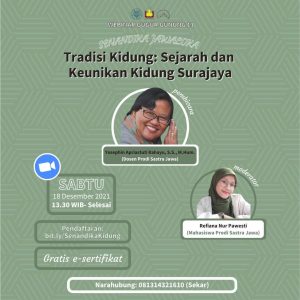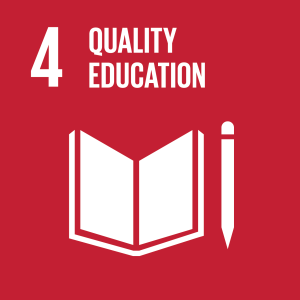On Saturday, December 18, 2021, the Javanese Literature program held a webinar titled "The Tradition of Kidung: History and Uniqueness of Kidung Surajaya." The webinar was one of two webinars organized to celebrate the anniversary of the Javanese Literature study program. This particular webinar was part of the 11th Gugur Gunung event. The first day of the webinar was moderated by Refiana Nur Pawesti, a Javanese Literature student class of 2020. The presentation was delivered by one of the expert Javanese Literature lecturers, Yosephin Apriastuti Rahayu, S.S., M.Hum.
In the first day's webinar, it was explained that Kidung Surajaya had been previously researched by Ms. Kartika Setyawati, a Javanese Literature lecturer at Universitas Gadjah Mada. The kidung was examined as part of her dissertation. At the beginning of the webinar, Ms. Apriastuti discussed the characteristics of kidung based on Zoetmulder's perspective in Kalangwan. One of Zoetmulder's opinions conveyed by Ms. Apriastuti was that most kidung texts were written in Bali. Zoetmulder also revealed that kidung texts typically contain excerpts of stories.
Ms. Apriastuti explained that Kidung Surajaya is part of the Merapi-Merbabu manuscript collection, which is only found in the National Library of Indonesia. It consists of seven pupuh (a type of poetic meter) with the metrical pattern of macapat. The text was written in the 17th century based on the long version colophon written in Buda script and Mid-Javanese language. Kidung Surajaya has two versions, the long version (D, F, H manuscripts) and the short version (B, E, G, I, J manuscripts). The long version contains around 87 lempir (leaves) with approximately 798 stanzas, while the short version contains 4-14 lempir.
In summary, Kidung Surajaya narrates the journey of Ki Singamada, who is grieving after the passing of his parents. The remarkable aspects of Kidung Surajaya are the advice from the teachers, the protagonist's journey, depictions of nature, the Surajaya initiation ceremony, various flora and fauna, betel leaf, food and drinks served, time indicators, and more. The kidung also provides insights into the agricultural practices of society, the surrounding natural environment, types of flowers, characteristics of women in the past, and much more.
Upon careful observation and analysis, implicit meanings can be found in the names of the characters. For instance, the name Surawani/Surajaya means a brave and victorious person, while the name Hantakarana Ragasamaya means a body that is resilient.
After studying the text, it can be concluded that the purpose of writing Kidung Surajaya was to bring comfort, alleviate sorrow, portray the essence of love, showcase beauty and self-expression, and increase praise. Based on the content and meanings shared, Kidung Surajaya provides many valuable lessons for reflection in life. Its uniqueness and life advice make it worthy of further study and exploration.





